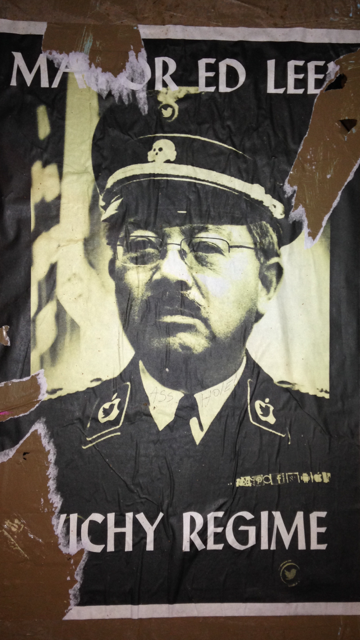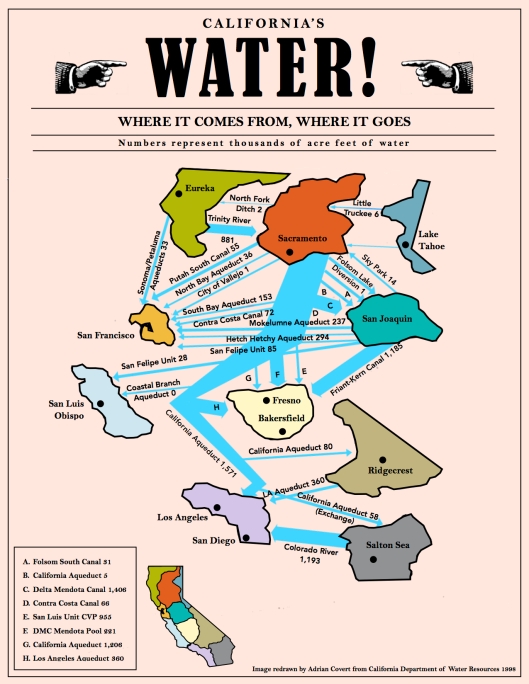
Photo Credit: Christopher Anderson/Magnum Photos/New York Magazine
Once again, Barack Obama has been sworn in as President of the United States. The time is therefore ripe to reflect on some of the excellent commentary and analysis from his first four years in office.
An exhaustive list this is not. Matt Tiabbi’s writings on the financial system, for example, defined the populist fury from Occupy to the Tea Party, and the national debate over the role of debt has hugely benefitted from the pen (or keyboard) of Paul Krugman. The past four years have also given us some analysis notable for being wrong (hint: his name rhymes with David Brooks).
But of all the reading I’ve done on American politics since just prior to the start of the 2008 primary season, three articles really stand out. Two are from the Atlantic–one each by Andrew Sullivan and James Fallows–and the third by New York Magazine‘s Jonathan Chait. As Obama’s second term agenda comes into focus–immigration, guns, and inequality–the emerging picture largely validates the claims made by these three authors, an altogether impressive feat in a punditocracy boiling with mediocrity.

What: Goodbye to All That: Why Obama Matters
Who: Andrew Sullivan, The Atlantic
When: November 2007
The Claim: Obama’s candidacy represents the end of Baby Boomer rule.
Published one year and two days before Obama defeated John McCain, right around the time Obama was buttering up Iowa Democrats with his electrifying Jefferson-Jackson speech, many people didn’t know what make of the hopeful Senator from Illinois. Sullivan did.
The Obama candidacy is about ending a war…a nonviolent civil war that has crippled America at the very time the world needs it most. It is a war about war—and about culture and about religion and about race. And in that war, Obama—and Obama alone—offers the possibility of a truce.
Goodby to All That was about the never-ending psychodrama of the Baby Boomer generation. Their youthful idealism had aged poorly, argued Sullivan, and the two leaders they had produced (Clinton and the younger Bush) embodied, to cartoonish perfection, all that was wrong with those born between 1945 and 1963: a deficit of self-control, a surfeit of self-importance, and a bottomless insecurity.
It wasn’t his positions–Obama largely campaigned on a boilerplate moderate-Democrat platform–but his style, confidence, and optimism which set him apart from his chief political opponent at the time, Hillary Clinton. And so Sullivan unleashes the analytic pearl of that historic primary:
As a liberal, [Hillary Clinton] has spent years in a defensive crouch against triumphant post-Reagan conservatism. Her liberalism is warped by what you might call a Political Post-Traumatic Stress Syndrome. Reagan spooked people on the left, especially those, like Clinton, who were interested primarily in winning power. She has internalized what most Democrats of her generation have internalized: They suspect that the majority is not with them, and so some quotient of discretion, fear, or plain deception is required if they are to advance their objectives. And so the less-adept ones seem deceptive, and the more-practiced ones, like Clinton, exhibit the plastic-ness and inauthenticity that still plague her candidacy. She’s hiding her true feelings. We know it, she knows we know it, and there is no way out of it.
Perhaps as Sullivan was typing these words, Hillary Clinton delivered a speech on at Plymouth State University in New Hampshire where she directly acknowledged the political failure of her generation, saying “I don’t want us to be the first generation of Americans to leave our country worse than when we found it”. Following four terms of Clinton-Bush, Americans were more interested in giving a new generation their first shot than giving the Boomers a fifth.

What: Obama, Explained
Who: James Fallows, The Atlantic
When: March 2012
The Question: Is Obama a ninja or a dilettante?
Following 20 years of Bush-Clinton-Bush, America was hungry for an outsider. In 2008, Barack Obama gave voters what they wanted. Within a year of his inauguration, however, the Obama administration was caught flat footed by a movement of conservative populists in revolt at everything the new President represented stood for: youth, diversity, and urbanism. Republicans were shockingly disrespectful of the President at home, while China was disrespecting him abroad. The Tea Party shellacked Democrats in the 2010 primary, taking back the House of Representatives and leaving many wondering if Obama, by jumping ahead of ultimate-fighter Hillary Clinton, had bitten off more than he could chew.
In the February before the Tea Party midterms, Bill O’Reilly asked Jon Stewart to assess Obama’s performance to that point. When Stewart replied that he couldn’t “tell if [Obama]’s a Jedi-Master, playing chess on a three level board way ahead of us, or if this is kicking his ass”, the always self-satisfied O’Reilly responded in amazement “you really don’t know?” as if it was clear to all but Stewart that Obama was in over his head.
Or, as James Fallows posed the question in his fantastic analysis of Obama’s first term:
Is [Obama] a skillful political player and policy visionary—a chess master who always sees several moves ahead of his opponents (and of the punditocracy)? Or is he politically clumsy and out of his depth—a pawn overwhelmed by events, at the mercy of a second-rate staff and of the Republicans?
Fallows’ answer was that Obama had shown both good and poor judgment, but that ultimately, he had “shown the main trait we can hope for in a president—an ability to grow and adapt—and that the reason to oppose his reelection would be disagreement with his goals, not that he proved unable to rise to the job. As time has gone on, he has given increasing evidence that the skills he displayed in the campaign were not purely a fluke”.
Fallows’ examples of Obama’s successful leadership were our improving China posture, the prevention of another Great Depression, America’s improved global standing, and the passage of Healthcare reform. Fair enough. But it is the journey, and not so much the destination, where James Fallows’ article really wins.

What: 2012 or Never
Who: Jonathan Chait, New York Magazine
When: February 2012
The Claim: The deepest effect of Obama’s election upon the Republicans’ psyche has been to make them truly fear, for the first time since before Ronald Reagan, that the future is against them”
“When jubilant supporters of Obama gathered in Grant Park on Election Night in 2008” writes Jonathan Chait, “Republicans saw a glimpse of their own political mortality. And a galvanizing picture of just what their new rulers would look like.”
Following defeat, Republicans were faced with a strategic decision: interpret Obama’s victory as the dawning of new majority and pivot the party as appropriate, or, interpret Obama’s victory as a fluke born of Bush fatigue and soldier on, demography be damned.
As James Fallows mentioned in Obama, Explained, the topic of Obama-as-fluke was a huge one for American conservatives. One of the reasons conservatives were so ecstatic following Mitt Romney’s victory over Obama in the first debate was how the President’s droning, lazy performance perfectly confirmed what they had been telling themselves on talk radio for years: Obama is empty calories, an overreaction to the Bush years, a blip on the radar, soon pushed aside as our truth goes marching on.
The Republican Party settled on a strategy of obstructing Obama’s agenda on all fronts, culminating in a standoff over an increase to the nation’s debt ceiling, a topic never before put to debate. The President was flummoxed as he suddenly found himself trapped in a Quixotean debate with Congress over whether or not the legislative branch was going to pay the bills it had itself racked up. Desperate to make a compromise prior to an unprecedented default on American debt,
Obama offered Republicans hundreds of billions of dollars in spending cuts and a permanent extension of Bush-era tax rates in return for just $800 billion in higher revenue over a decade. Instead the party bet everything on 2012, preferring a Hail Mary strategy. That is the basis of the House Republicans’ otherwise inexplicable choice to vote last spring for [the Paul Ryan] budget plan that would lock in low taxes, slash spending, and transform Medicare into private vouchers—none of which was popular with voters.
The way to make sense of that foolhardiness is that the party has decided to bet everything on its one “last chance.” Not the last chance for the Republican Party to win power—there will be many of those, and over time it will surely learn to compete for nonwhite voters—but its last chance to exercise power in its current form, as a party of anti-government fundamentalism powered by sublimated white Christian identity politics. And whatever rhetorical concessions to moderates and independents the eventual Republican nominee may be tempted to make in the fall, he’ll find himself fairly boxed in by everything he’s already done this winter to please that base.
If they lose their bid to unseat Obama, they will have mortgaged their future for nothing at all. And over the last several months, it has appeared increasingly likely that the party’s great all-or-nothing bet may land, ultimately, on nothing. In which case, the Republicans will have turned an unfavorable outlook into a truly bleak one in a fit of panic. The deepest effect of Obama’s election upon the Republicans’ psyche has been to make them truly fear, for the first time since before Ronald Reagan, that the future is against them.
Chait’s ability to synthesize anxiety as the driving force behind the Republican Party made his essay one of the best of the GOP’s 2012 primary season.
THE NEXT FOUR YEARS
Republican opposition to Obama’s first term was characterized by extraordinary slander, or as as Stephen Colbert put it, “a torch and pitchfork-wielding mob empty of all thoughts. An injured, vengeful animal lashing out blindly at shapes and colors.” Republicans questioned Obama’s birth certificate, his college transcripts, and his faith. They called him a socialist, a liar, a tyrant, and an arrogant elitist with death panels. They accused him of launching “apology tours”, “palling around with terrorists”, and harboring “a Kenyan anti-colonial worldview”. Their leader in the Senate said that the number one priority of the Party was preventing Obama’s reelection.
But that didn’t happen. Not only was Obama reelected, but nearly everything else went wrong for the GOP. Marriage equality was enshrined in three states and cannabis became legal in two. In California, Democrats took supermajorities of both houses of the state legislature and every single statewide constitutional office.
Today, with Republicans on the ropes and their King exposed, Obama is on the verge of becoming a transformative President, putting to bed a coalition which has largely governed the United States since 1978, and in the process showing himself to be a master chess player. On the Fiscal Cliff, Obama boxed Republicans into voting to increase taxes on the rich in exchange for virtually nothing. On the debt ceiling, the GOP has boxed itself into debating itself over whether or not it will pay its own bills. On immigration, an issue seen critical by GOP strategists, the party will likely split in two. The same is likely true for gun control and disaster-preparedness, following both the Sandy Hook massacre and Superstorm Sandy. Given the high possibility of GOP disunity on all these fronts, Republicans themselves are beginning to predict a Democratic House-takeover in 2014, and Democrats keeping the Presidency in 2016.
More often than not, pundits get it wrong. Which is why it’s so satisfying to discover intelligent analysts getting it right. In a world of armchair pontificators (guilty), it’s good to know we still got some pros.

















